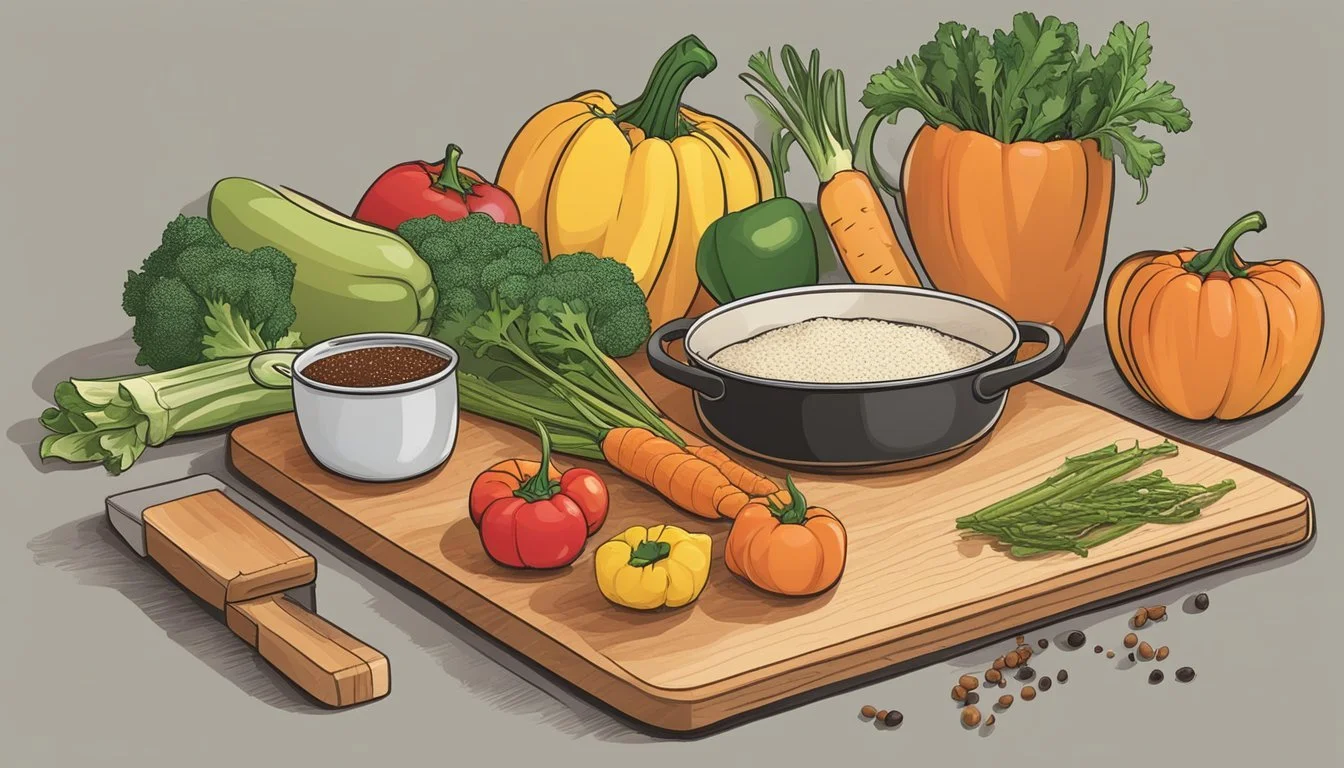How to Cook When You're Trying to Cook Less Meat
Embracing Plant-Based Alternatives
Cooking with less meat is an adaptable culinary approach that caters to a range of dietary preferences, from vegetarian to flexitarian lifestyles. Individuals often reduce their meat consumption to align with health goals or environmental concerns, embracing the health benefits of a plant-based diet. Replacing meat with alternative protein sources such as legumes, tofu, and a variety of vegetables can lead to a more sustainable and nutritious way of eating.
Incorporating meatless meals into one's routine doesn't mean sacrificing flavor or satisfaction. Creative cooking techniques and the rich diversity of plant-based ingredients available make it easy to craft delicious and hearty dishes. Dishes such as bean casseroles (What wine goes well with casseroles?) or veggie-laden stir-fries provide ample protein and nutrients, ensuring that even meatless meals are fulfilling and balanced.
Understanding the fundamentals of a less meat-centric kitchen empowers home cooks to experiment with a variety of ingredients, discovering new flavors and textures. For example, using mushrooms or chickpeas as a base can mimic the umami and heartiness traditionally found in meat dishes. This transition not only introduces individuals to an array of new recipes but also contributes to a healthier lifestyle and a reduced environmental footprint.
Understanding the Basics of a Less-Meat Diet
Reducing meat consumption has health benefits and environmental significance. A less-meat diet often incorporates plant-based proteins and emphasizes a wide range of nutrients.
Health and Nutritional Considerations
A decrease in meat intake, especially red and processed meats, can lower the risk of heart disease, diabetes, and cancer. A balanced less-meat diet is rich in nutrients and fiber, coming from legumes, vegetables, and whole grains. These food groups are essential for maintaining health and providing a complete nutrient profile with fewer calories.
Environmental and Ethical Impacts
The production of meat, particularly beef, has a significant environmental impact, contributing to greenhouse gas emissions and land degradation. Ethically, reducing meat consumption can reduce the demand for large-scale animal farming, which often raises concerns regarding animal welfare.
Defining a Flexitarian Approach
The flexitarian diet is a semi-vegetarian approach where individuals significantly reduce meat intake without eliminating it altogether. This diet is flexible, allowing for occasional meat consumption, but emphasizes plant-based foods as the primary source of nutrients.
Key Principles of Meat Reduction
The principles of reducing meat consumption encompass:
Variety: Including a wide range of plant-based foods.
Balance: Ensuring all essential nutrients are obtained.
Moderation: Limiting the quantity of meat consumed when it is included in the diet.
The Role of Umami in Satisfying Cravings
Umami is a savory taste present in foods like soy sauce, miso, cumin, and mushrooms. It can satisfy cravings for meat due to its depth of flavor. Integrating umami-rich foods into a less-meat diet can make meals more satisfying without relying on animal proteins.
Planning Your Meat-Reduced Meals
Transitioning to meals with less meat doesn't mean sacrificing flavor or satisfaction. By focusing on the nutritional balance of proteins and vegetables, smart prepping and cooking strategies, integrating meat substitutes, and exploring international dishes, you can create fulfilling and varied meat-reduced meals.
Balancing Your Plate with Proteins and Veggies
When reducing meat in your meals, aim for a plate comprised of half vegetables, a quarter of whole grains, and a quarter of plant-based proteins. Combining vegetables like broccoli or kale with grains such as quinoa or brown rice, and proteins like beans, lentils, or chickpeas, ensures a balanced meal. Add a touch of nuts, seeds, or nut butter for an extra protein boost.
Prepping and Cooking in Batches
Cooking legumes and grains in large quantities can save time and simplify meal planning. Lentils or chickpeas can be prepared in low-sodium vegetable broth for deeper flavor and stored in the freezer. Grains like millet or rice can be used as a base for various dishes, including stir-fries or salads, and reheat well for quick, easy recipes.
Integrating Meat Substitutes and Alternatives
Incorporating plant-based meat substitutes like tofu, tempeh (What wine goes well with tempeh?), or vegan meatballs can add substance and texture to your meals. For example, crumbled tofu can be seasoned and used in tacos or quesadillas, while vegan meatballs made from lentils and mushrooms can create a satisfying meatless version of spaghetti or a banh mi sandwich.
Experimenting with International Cuisines
Exploring international cuisines offers a diverse range of vegetarian and vegan dishes inherently designed for meatless eating. Consider trying recipes like pasta e fagioli, vegetable paella, or lasagna that use veggies and legumes as primary ingredients. Experimenting with various herbs and spices can bring a new dimension to the familiar vegetables and proteins on your plate.
Recipe Ideas for Meatless Cooking
An array of meatless recipes can provide satisfying and nutritious meals using a diverse mix of grains, vegetables, and beans. These recipes are crafted to deliver rich flavors and fulfilling textures that cater to both vegetarians and those looking to reduce meat consumption.
Hearty Vegetarian Soups and Stews
Vegetarian soups and stews can be as robust as their meat-based counterparts. Lentils, beans, and hearty vegetables like kale and sweet potatoes create a dense and flavorful base. A Sweet Potato Chili, thick with black beans and spiced with masa harina, offers a full-bodied taste experience. Similarly, soups with a blend of broccoli, cauliflower (how long does cauliflower last?), and potatoes can be pureed to a creamy consistency without the need for dairy.
Meat-Free Salads that Satisfy
Salads need not be mere side dishes; they can stand as a complete meal. Incorporating grains like quinoa or farro adds substance, while a variety of vegetables—tomatoes, cabbage, and roasted veggies—lend texture and nutrition. Adding elements like fruit and nuts can introduce new flavors and crunch. For instance, a kale salad sprinkled with parmesan and tossed with a tangy vinaigrette satisfies the palate while remaining meat-free.
Creating Filling Meatless Sandwiches and Wraps
Sandwiches and wraps without meat can be delightfully satisfying when assembled with the right ingredients. Quesadillas filled with beans and a blend of cheeses, spiced with jalapeños, demonstrate that a meatless option doesn't compromise on taste. Baked falafel wrapped in pita with veggies and tahini sauce provides a nutritious, protein-packed lunch option. Use hearty breads or tortillas to complement the fillings.
Rich and Flavorful Vegetarian Casseroles
Casseroles are all about the layering of flavors, and meatless versions are no exception. An eggplant (What wine goes well with eggplant?) parmesan casserole layers sliced eggplant (What wine goes well with eggplant?), marinara sauce, and cheese to create a satisfying main dish. A rice-stuffed bell pepper casserole, filled with a mixture of grains, cheeses, and seasonings, baked until tender, offers a colorful and enticing meat-free alternative that can please a crowd.
Tips for Eating Less Meat Without Missing It
Transitioning to a diet with less meat is made easier by choosing satisfying substitutes, flavor-rich seasonings, and a variety of textures. It's about finding balance in meals that provide the same satiety and enjoyment as their meat-containing counterparts.
Finding the Right Meat Substitutes for Your Palate
Exploring meat alternatives that appeal to individual tastes is essential. Options like firm tofu and tempeh offer a meat-like chewiness and absorb flavors well. Portobello mushrooms and eggplant (how long does eggplant last?) can mimic the savory depth often called umami, which is characteristic of meat. Varied substitutions ensure meals remain exciting and satisfying.
Enhancing Dishes with Spices and Herbs
Introducing a wide array of spices and herbs can make vegetables and meat substitutes come alive. Incorporating cumin or miso can add a layer of depth to dishes, whereas fresh herbs bring brightness and complexity. A splash of soy sauce, known for its umami quality, enhances the overall taste without the need for meat.
Incorporating Different Textures and Flavors
Combining ingredients with diverse textures—crunchy nuts, smooth legumes, and juicy tomatoes—creates dishes that are satisfying on multiple sensory levels. Texture plays a significant role in the eating experience, and meals that include a variety of them tend to be more fulfilling.
Educating the Palate to Appreciate Vegetarian Flavors
Gradually incorporating more vegetarian and vegan dishes allows the palate to adjust and appreciate the flavors inherent to plant-based ingredients. Over time, taste preferences can shift to favor these dishes, reducing the desire for meat-centric meals and celebrating vegetarian diversity.
Substituting Meat in Tradition-Based Recipes
Transitioning to less meat doesn't mean sacrificing the flavors and experiences of traditional recipes. Thoughtful substitutions can maintain the essence of the dish while offering new vegetarian twists.
Reworking Family Favorites with Vegetarian Twists
Family recipes passed down through generations can be reimagined by replacing meat with plant-based alternatives. For instance, a classic spaghetti bolognese can be transformed by using lentils or plant-based ground meat instead of beef. Similarly, lasagna layers may embrace ricotta and spinach, or incorporate crumbled tofu for a protein-rich experience that mimics the texture of traditional lasagna.
Tacos: Substitute shredded chicken or beef with spiced black beans or seasoned portobello mushrooms.
Paella: Use artichoke hearts and olives instead of sausage and seafood for a flavorful dish.
Holiday Meals and Special Occasions
Festive gatherings often center around meat-based dishes, but there are creative ways to retain the celebratory spirit with meatless options. A nut roast or a well-prepared tofurky can stand in for the classic ham or turkey centerpiece. On the side, one can serve indulgent stuffed portobello mushrooms in place of beef or steak, providing a savory experience that's both satisfying and suitable for a celebration.
Salad: For a lighter touch, a robust salad with grilled eggplant (What wine goes well with grilled eggplant?) or roasted cauliflower can complement the festive table.
Giving Classic Comfort Foods a Meatless Makeover
Comfort foods can be redefined with meatless variants that still cater to cravings for homely warmth. A hearty eggplant parmesan (What wine goes well with eggplant parmesan?) offers a substantial texture that mimics meat, while cauliflower can be a delectable substitute in a creamy cauliflower steak alfredo.
Bacon: Crisp slices of smoked tempeh provide a similar crunch and smokiness to bacon.
Sausage: Swap sausage in any dish with spiced chickpea patties or veggie sausage links.
Transitioning Your Household to Less Meat Consumption
When a household decides to consume less meat, effective communication and smart meal planning are key. Gradually integrating a less-meat routine involves understanding the health and environmental benefits, and tweaking daily meals to accommodate all family members, including kids and picky eaters.
Talking to Family about Health and Environment
It is essential to discuss with family members why reducing meat is beneficial for their health and the environment. Emphasizing the link between a plant-based diet and a reduced risk of heart disease, stroke, and cancer can make the health benefits tangible. Relating the environmental impact, such as the decrease in greenhouse gas emissions associated with vegetarian and flexitarian diets, can underscore the importance of the transition.
Meal Planning with Less Meat for Kids and Picky Eaters
Planning meals that appeal to kids and picky eaters is crucial when reducing meat consumption. Introducing meatless options like veggie-packed sandwiches or fruit-laden pancakes for breakfast can make the transition more palatable. Here are some strategies for mealtime:
Involve Them: Allow kids to choose from a list of plant-based ingredients for their meals.
Be Creative: Craft meals that are visually appealing using colorful fruits and vegetables.
Familiar Foods: Start by adjusting familiar recipes, such as using lentils in tacos instead of beef.
Adapting to a Less-Meat Lifestyle Gradually
A gradual change often leads to more sustainable habit formation. Households can ease into a less-meat lifestyle by:
Meatless Days: Designating certain days of the week, like Meatless Monday, to go without meat.
Smaller Portions: Reducing the meat portion in dishes and filling the gap with vegetables or legumes.
Alternate Proteins: Exploring plant-based proteins and incorporating them into the family diet.
By implementing these strategies, households can confidently and seamlessly transition to consuming less meat.






